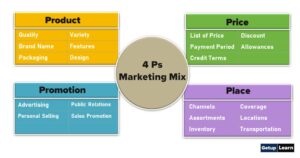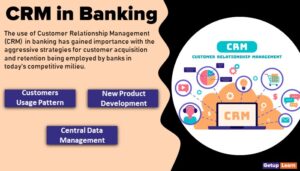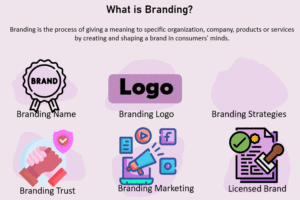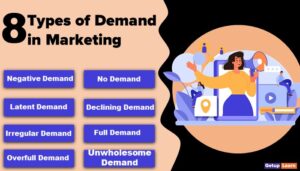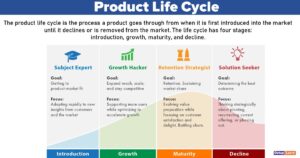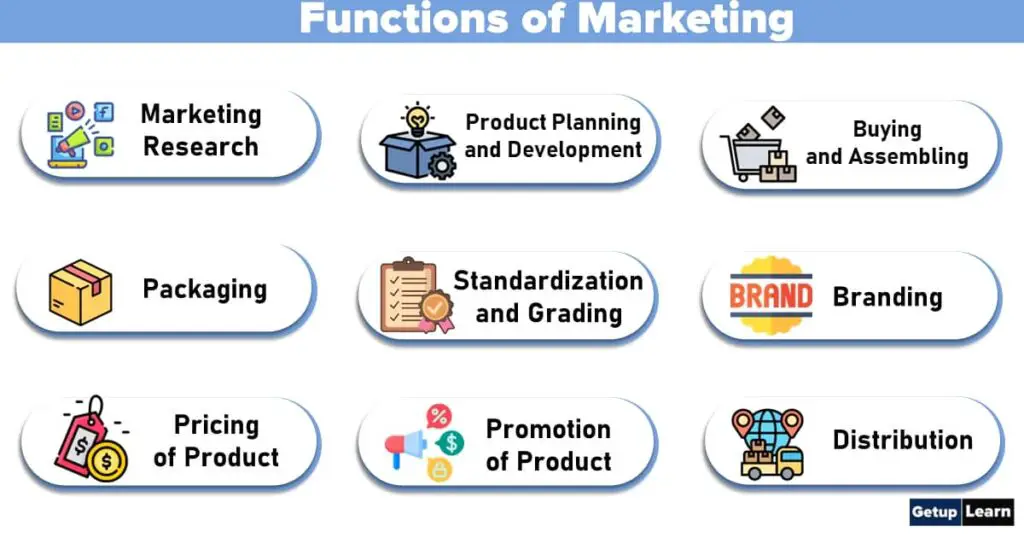
Table of Contents
Functions of Marketing
These are essential functions of marketing explained below:
- Marketing Research
- Product Planning and Development
- Buying and Assembling
- Packaging
- Standardization and Grading
- Branding
- Pricing of Product
- Promotion of Product
- Distribution
- Selling
- Storage and Warehousing
- Transportation
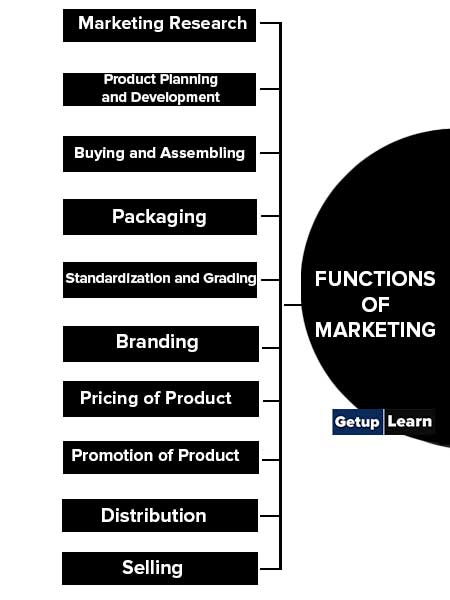
Marketing Research
Marketing research involves collecting and analyzing facts relevant to various aspects of marketing. It is a process of collecting and analyzing information regarding customer needs and buying habits, the nature of competition in the market, prevailing prices, distribution networks, effectiveness of advertising media, etc.
Marketing research gathers, records, and analyzes facts to arrive at rational decisions and develop suitable marketing strategies.
Product Planning and Development
As you know marketing starts much before the actual production. The marketers gather information regarding what are the needs of the consumers and then decide upon what to produce. So, the task of marketing begins with planning and designing a product for the consumers.
It can also be done while modifying and improving an already existing product. For example, nowadays we find much better soaps and detergent powders than we used to get earlier. Similarly, we have many new products introduced almost on a regular basis.
Buying and Assembling
Buying and assembling activities as a part of marketing refer to buying and collecting of required goods for resale. This function of marketing is primarily relevant to those business organizations that are engaged in trading activities. In the context of manufacturing organizations, buying and assembling involve buying raw materials and components required for the production of finished goods.
Packaging
Packaging involves putting the goods in attractive packets according to the convenience of consumers. Important considerations to be kept in view in this connection are the size of the package and the type of packaging material used.
Goods may be packaged in bottles (plastic or glass), boxes (made of tin, glass, paper, plastic), cans, or bags. The size of the package generally varies from a few grams to a few kilograms, one piece to a number of pieces of a product, or in any other suitable quantity in terms of weight, count, length, etc.
Packaging is also used as a promotional tool as suitable and attractive packages influence the demand for the products. It may be noted that packaging is different from packing, which refers to putting goods in suitable containers for transportation purposes.
Standardization and Grading
Standardization refers to the development of standards for the production of goods with respect to shape, design, color, and other characteristics. If products are standardized, customers are able to identify a product and its characteristics very well.
So goods can be sold by sample or description. Standardization helps in promoting the sale of the product by increasing consumers’ confidence in the product’s quality. Grading involves separating products into different classes on the basis of certain predetermined standards relating to size and quality. Grading is required in the case of agricultural, forest, and mineral products such as cotton, sugar cane iron ore, coal, timber, etc.
Branding
Branding means giving an attractive name, symbol, or identity mark to the product to make a product different from others so that it is known by that name or symbol, or mark. For example, Surf is the brand name of a detergent powder produced by Hindustan Unilever Limited (HUL).
Similarly, you must be familiar with brands like Colgate for toothpaste, Lux for soap, and so on.
Pricing of Product
Pricing involves decisions regarding the fixation of product prices, keeping in view the product costs, the capacity of customers to pay, and the prices of competitive products. It is an important decision as it influences the sales and so also the profits. So pricing has to be done very carefully.
Promotion of Product
Promotional activities include advertising, personal selling, sales promotion, and publicity. All promotional activities involve communication with the existing and prospective customers whereby they are made aware of the product, its distinctive features, price, availability, etc. The objective of promotional activities is to motivate the customers to buy the product.
Distribution
Distribution refers to those activities that are undertaken for the sale of products to the customers and the physical transfer thereof. The first aspect i.e., the sale of products involves the use of middlemen such as wholesalers and retailers whose services are used for making the products available at convenient points and helping in their sale to the ultimate consumers.
The second aspect i.e., the physical transfer involves warehousing and transportation of goods from the points of production to the points of sale or the consumer. The objective of distribution activities is to ensure that consumers get the goods and services at the place and time most convenient to them and in the desired quantity.
Selling
Selling is an important function of marketing whereby the ownership of goods and services is transferred from the seller to the buyer for a consideration known as price. To initiate and complete the process of selling, the seller has to inform the prospective buyer about the availability of goods, the nature, and uses of products, their prices, and the needs of the customers that may be effectively satisfied by the product. In the process, he arouses customers’ interest in the product and persuades them to buy it.
Storage and Warehousing
Storage refers to holding and preserving goods from the time of their procurement or production till the time of their sale. In other words, storage involves making suitable arrangements for preserving the goods till they are bought by the consumers and delivered to them.
Warehousing is synonymous with storage but is normally used for a large-scale storage facility for goods and commodities. You must have seen cold storage where vegetables like tomatoes, cabbage, potato, etc. are stored to be consumed throughout the year. In marketing, it is essential to store raw materials and finished goods to be used later by the company for production or for resale.
Transportation
Transportation refers to the physical movement of goods from one place to another. In marketing, transport as an activity refers to the physical movement of raw material as well as finished goods from the place of production to the place of consumption. Goods are transported through various means like railways, roadways, waterways, and airways.
For heavy and bulky goods, the railways and waterways are the best. For other goods, it depends upon the demand, cost involved, urgency, nature of the goods, etc. to decide about a suitable means of transportation.
Objectives of Marketing
Following are the objectives of marketing given below:
- Provide Satisfaction to Customers
- Increase in Demand
- Provide Better Quality Product to Customers
- Creating Goodwill For Organisation
- Generate Profitable Sales Volume
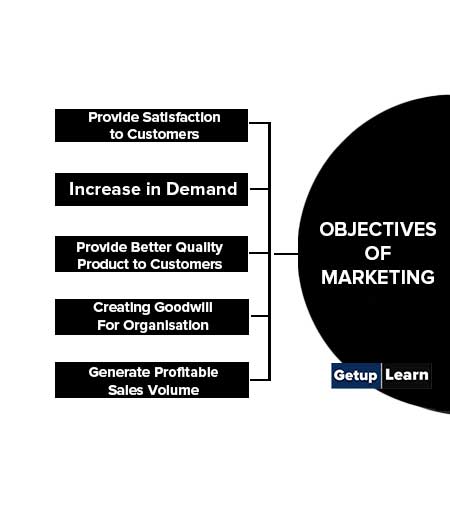
Provide Satisfaction to Customers
All marketing activities are directed toward customer satisfaction. Marketing starts with ascertaining consumer needs and producing goods that satisfy those needs most effectively. Not only that the pricing and distribution functions of marketing are also planned accordingly.
Increase in Demand
Through advertising and other sales promotional efforts, marketing aims at creating additional demand for its products. Satisfied customers also help in creating new customers. For example, if you buy a ‘gel pen’ and feel satisfied, next time also you will buy the same pen and obviously when you tell others about it they will also feel like giving it a try.
Provide Better Quality Product to Customers
This is a basic objective of marketing. The business house tries to update and upgrade its knowledge and technology to continuously provide better products. If they do not do so, they will be phased out through the competition.
Creating Goodwill For Organisation
Another objective of marketing is to build a good public image and create goodwill for the organization. This helps in maintaining loyalty to the product and accepting new products from the same company.
Generate Profitable Sales Volume
The ultimate objective of all marketing efforts is to generate profitable sales volumes for the business. Taking care of customer needs and wants by providing the required goods and services at prices they can afford, and at places and timing that are convenient to them ultimately lead to increased sales and profits.
Characteristics of Marketing
Let’s discussed the characteristics of marketing in detail:
- Applies to Profit and Non-profit Organisations
- More Than Just Persuading Customers
- Begins With Customer Needs
- Does Not Do It Alone
- Builds a Relationship With the Customer

Applies to Profit and Non-profit Organisations
This definition applies to both profit and non-profit organizations. Profit is the objective for most business firms. But another type of organization may seek more members or donations or acceptance of an idea.
Consumers or clients may be individual consumers, business firms, non-profit organizations, government agencies, or even foreign nations. While most customers and clients pay for goods and services they receive, others may receive them free of charge or at a reduced price through private or government support.
More Than Just Persuading Customers
Marketing is not just selling and advertising, as most people think. In fact, the aim of marketing is to identify customers’ needs and meet those needs so well that the product almost sells itself. This is true whether the product is a physical good, a service, or even an idea.
If the whole marketing job has been done well, customers do not need much persuading. They will be ready to buy. And after consuming the product if they are satisfied then they will come back for more.
Begins With Customer Needs
Marketing should begin with potential customer needs not with the production process. Marketing should try to anticipate needs and then it should determine what goods and services are to be developed, including decisions about product design and packaging; prices or fees; credit and collection policies; use of middlemen; transporting and storing facilities; advertising and sales policies and after the sale, installation, customer service, warranty and perhaps even disposal policies.
Does Not Do It Alone
It means that marketing by interpreting customers’ needs should provide direction for production activities accounting and financial activities and research and development activities and try to coordinate them. Marketing by itself can never be able to satisfy the needs and wants of the customers. It cannot exist in a vacuum. In fact, marketing needs the cooperation of other functional areas to be successful.
Builds a Relationship With the Customer
Marketing tries to identify and satisfy customer needs and wants. Its activities do not end with a single sale but rather it tries to develop a relationship with the customer. So that in the future, when the customer has the same need again or some other need that the firm can meet other sales will follow. A long-lasting relationship is beneficial to both the firm and the customer.
What are the functions of marketing?
Functions of marketing are given below:
1. Marketing Research
2. Product Planning and Development
3. Buying and Assembling
4. Packaging
5. Standardization and Grading
6. Branding
7. Pricing of Product
8. Promotion of Product
9. Distribution
10. Selling
11. Storage and Warehousing
12. Transportation.
What are the objectives of marketing?
Objectives of marketing:
1. Provide Satisfaction to Customers
2. Increase in Demand
3. Provide Better Quality Products to Customers
4. Creating Goodwill For Organisation
5. Generate Profitable Sales Volume.
What are the characteristics of marketing?
These are the characteristics of marketing:
1. Applies to Profit and Non-profit Organisations
2. More Than Just Persuading Customers
3. Begins With Customer Needs
4. Does Not Do It Alone
5. Builds a Relationship With the Customer.

